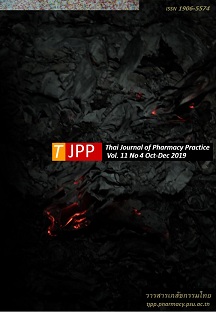ขนาดยาฟอสโฟไมซินที่เหมาะสมในการรักษาการติดเชื้อ Pseudomonas aeruginosa ในผู้ป่วยวิกฤตโดยใช้การจำลองสถานการณ์ของมอนติคาร์โล
Main Article Content
บทคัดย่อ
วัตถุประสงค์: เพื่อทำนายปริมาณขนาดยาฟอสโฟมัยซินที่เหมาะสมในการรักษาการติดเชื้อ P.aeruginosa ในผู้ป่วยวิกฤต วิธีการ: ใช้วิธีการ E-test ในการทดสอบความไวเชื้อในหลอดทดลอง เป้าหมายของร้อยละของระยะเวลาที่ระดับยาในกระแสเลือดอยู่เหนือค่า MIC (T>MIC) คือร้อยละ 70 และ 100 ใช้การจำลองสถานการณ์ของมอนติคาร์โลในการคำนวณ T>MIC หลังการรักษาด้วยยาฟอสโฟมัยซินในวันที่ 1 และวันที่ 5 และนำค่าทางเภสัชจลนศาสตร์ดังกล่าวมาใช้ในการคำนวณ probability of target attainment (PTA) และ cumulative fraction of response (CFR) ผลการวิจัย: ค่า MIC ของยาฟอสโฟมัยซินอยู่ระหว่าง 3 มก./ลิตร ถึง มากกว่า 1,024 มก./ลิตร ค่า MIC50 และ MIC90 เท่ากับ 64 มก./ลิตร และ 128 มก./ลิตร ตามลำดับ ในวันแรกของการรักษา ค่า T>MIC เป้าหมาย ร้อยละ 70 และ 100 ยาสามารถยับยั้งเชื้อที่มีค่า MIC 64 มก./ลิตร และ 32 มก./ลิตร ตามลำดับโดยมีค่า PTA มากกว่าร้อยละ 80 มีวิธีการให้ยาฟอสโฟมัยซินจำนวน 5 แนวทางที่สามารถยับยั้งเชื้อที่มี MIC 128 มก./ลิตร ที่ T>MIC ร้อยละ 70 และมีจำนวน 3 แนวทางที่สามารถยับยั้งเชื้อที่มี MIC 64 มก./ลิตร ที่ T>MIC ร้อยละ 100 โดยมีค่า PTA มากกว่าร้อยละ 80 เมื่อกำหนด CFR เป้าหมายที่ ร้อยละ 80 พบว่าการให้ฟอสโฟมัยซินจำนวน 9 แนวทางสามารถยับยั้งเชื้อตามเป้าหมาย T>MIC ร้อยละ 70 และมีเพียง 1 แนวทางที่สามารถยับยั้งเชื้อตามเป้าหมาย T>MIC ร้อยละ 100 อย่างไรก็ตาม ยาฟอสโฟมัยซินทุกแนวทางที่ทดสอบสามารถยับยั้งเชื้อโดยบรรลุเป้าหมาย PTA และ CFR มากกว่าร้อยละ 80 ในวันที่ 5 ของการรักษา สรุป: ในช่วงแรกของการรักษาการติดเชื้อที่รุนแรงในผู้ป่วยวิกฤตควรยืดระยะเวลาในการบริหารยาฟอสโฟมัยซินเข้าสู่กระแสเลือดร่วมกับการใช้ยาในขนาดสูง อย่างไรก็ตาม แนวทางการบริหารยาฟอสโฟมัยซินที่ทำการทดสอบทุกแนวทางให้ผลลัพธ์ในการรักษาที่ใกล้เคียงกันในวันที่ 5 ของการรักษา
คำสำคัญ: ระยะเวลาที่ระดับยาในกระแสเลือดอยู่เหนือค่า MIC, เภสัชจลนศาสตร์, เภสัชพลศาสตร์, การจำลองสถานการณ์ของมอนติคาร์โล
Article Details
ผลการวิจัยและความคิดเห็นที่ปรากฏในบทความถือเป็นความคิดเห็นและอยู่ในความรับผิดชอบของผู้นิพนธ์ มิใช่ความเห็นหรือความรับผิดชอบของกองบรรณาธิการ หรือคณะเภสัชศาสตร์ มหาวิทยาลัยสงขลานครินทร์ ทั้งนี้ไม่รวมความผิดพลาดอันเกิดจากการพิมพ์ บทความที่ได้รับการเผยแพร่โดยวารสารเภสัชกรรมไทยถือเป็นสิทธิ์ของวารสารฯ
เอกสารอ้างอิง
2. Michalopoulos AS, Livaditis IG, Gougoutas V. The revival of fosfomycin. Int J Infect Dis 2011; 15: e732-9.
3. Joukhadar C, Klein N, Dittrich P, Zeitlinger M, Geppert A, Skhirtladze K, et al. Target site penetration of fosfomycin in critically ill patients. J Antimicrob Chemother 2003; 51: 1247-52.
4. Walsh CC, McIntosh MP, Peleg AY, Kirkpatrick CM, Bergen PJ. In vitro pharmacodynamics of fosfomycin against clinical isolates of Pseudomonas aeruginosa. J Antimicrob Chemother 2015;70:3042-50.
5. Palavutitotai N, Jitmuang A, Tongsai S, Kiratisin P, Angkasekwinai N. Epidemiology and risk factors of extensively drug-resistant Pseudomonas aeruginosa infections. Plos one 2018; 13: e0193431.
6. Ruiz-Garbajosa P, Canton R. Epidemiology of antibiotic resistance in Pseudomonas aeruginosa. Implications for empiric and definitive therapy. Rev Esp Quimioter 2017;30 Suppl 1: 8-12.
7. National antimicrobial resistant service center, Thai- land (NARST). Antimicrobial Resistance 2000-2018 [online]. 2019 [cited April 3, 2019]. Available from: https://narst.dmsc.moph.go.th/data/AMR%202000-20 18-12M.pdf
8. Asuphon O, Montakantikul P, Houngsaitong J, Kiratisin P, Sonthisombat P. Optimizing intravenous fosfomycin dosing in combination with carbapenems for treatment of Pseudomonas aeruginosa infections in critically ill patients based on pharmacokinetic/ pharmacodynamic (PK/PD) simulation. Int J Infect Dis 2016; 50: 23-9.
9. Falagas ME, Kastoris AC, Karageorgopoulos DE, Rafailidis PI. Fosfomycin for the treatment of infec- tions caused by multidrug-resistant non-fermenting Gram-negative bacilli: a systematic review of micro- biological, animal and clinical studies. Int J Antimi crob Agents 2009; 34: 111-20.
10. Clinical and Laboratory Standards Institute. Performance standards for antimicrobial susceptibi- lity testing. 28th ed. Wayne: Clinical and Laboratory Standards Institute; 2018.
11. Parker SL, Frantzeskaki F, Wallis SC, Diakaki C, Giamarellou H, Koulenti D, et al. Population pharma cokinetics of fosfomycin in critically ill patients. Antimicrob Agents Chemother 2015; 59: 6471-6.
12. Rhodes A, Evans LE, Alhazzani W, Levy MM, Antonelli M, Ferrer R, et al. Surviving sepsis campaign: international guidelines for management of sepsis and septic shock: 2016. Intensive Care Med 2017; 43: 304-77.
13. Masich AM, Heavner MS, Gonzales JP, Claeys KC. Pharmacokinetic/pharmacodynamic considerations of beta-lactam antibiotics in adult critically ill patients. Curr Infect Dis Rep 2018;20:9.
14. Heavner MS, Claeys KC, Masich AM, Gonzales JP. Pharmacokinetic and pharmacodynamic considera tions of antibiotics of last resort in treating gram-negative infections in adult critically ill patients. Curr Infect Dis Rep 2018; 20: 10.
15. Parker S, Lipman J, Koulenti D, Dimopoulos G, Roberts JA. What is the relevance of fosfomycin pharmacokinetics in the treatment of serious infections in critically ill patients? A systematic review. Int J Antimicrob Agents 2013; 42: 289-93.
16. Dinh A, Salomon J, Bru JP, Bernard L. Fosfomycin: efficacy against infections caused by multidrug-resistant bacteria. Scand J Infect Dis 2012; 44: 182-9.
17. Shorr AF, Pogue JM, Mohr JF. Intravenous fosfomycin for the treatment of hospitalized patients with serious infections. Expert Rev Anti Infect Ther. 2017; 15: 935-45.
18. Bilal H, Peleg AY, McIntosh MP, Styles IK, Hirsch EB, Landersdorfer CB, et al. Elucidation of the pharmacokinetic/pharmacodynamic determinants of fosfomycin activity against Pseudomonas aerugino- sa using a dynamic in vitro model. J Antimicrob Chemother 2018; 73: 1570-8.
19. Samonis G, Maraki S, Karageorgopoulos DE, Vouloumanou EK, Falagas ME. Synergy of fosfo mycin with carbapenems, colistin, netilmicin, and tigecycline against multidrug-resistant Klebsiella pneumoniae, Escherichia coli, and Pseudomonas aeruginosa clinical isolates. Eur J Clin Microbiol Infect Dis 2012; 31: 695-701.
20. Perdigao Neto LV, Oliveira MS, Martins RCR, Marchi AP, Gaudereto JJ, da Costa L, et al. Fosfomycin in severe infections due to genetically distinct pan-drug-resistant Gram-negative microorga nisms: synergy with meropenem. J Antimicrob Chemother 2019; 74: 177-81.
21. Flamm RK, Rhomberg PR, Lindley JM, Sweeney K, Ellis-Grosse EJ, Shortridge D. Evaluation of the bactericidal activity of fosfomycin in combination with selected antimicrobial comparison agents when tested against gram-negative bacterial strains using time-kill curves. Antimicrob Agents Chemother 2019; 63: e02549-18.


